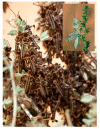Locust Bacterial Symbionts: An Update
- PMID: 32987763
- PMCID: PMC7598710
- DOI: 10.3390/insects11100655
Locust Bacterial Symbionts: An Update
Abstract
As one of the world's most infamous agricultural pests, locusts have been subjected to many in-depth studies. Their ability at one end of their behavioral spectrum to live as solitary individuals under specific conditions, and at the other end of the spectrum to form swarms of biblical scale, has placed them at the focus of vast research efforts. One important aspect of locust ecology is that of their interactions with the bacteria that reside in and on them. Although this aspect of locust ecology has been little studied relative to the mainstream locust research, these bacteria have been shown both to affect locust immunity and to participate in maintaining swarm integrity through the secretion of attractant volatiles. The interaction between locusts and their bacteria seems, however, to be bi-directional, with the bacteria themselves, as recently shown, being influenced by their host's swarming tendencies. This seems to be a consequence of the bacterial composition in the locust's gut, reproductive organs, and integument undergoing change with the change in their host's behavior. In this review we describe the current state of knowledge of the locust-bacteria interactions (data exists mainly for the desert and the migratory locusts), as well as highlighting some newly-gained understanding; and offer perspectives for future research.
Keywords: bacteria; desert locust; locust; locust symbionts; migratory locust.
Conflict of interest statement
The authors declare no conflict of interest.
Figures


References
-
- Pener M.P., Simpson S.J. Locust phase polyphenism: An update. Adv. Insect Phys. 2009;36:1–272.
-
- Cullen D.A., Cease A.J., Latchininsky A.V., Ayali A., Berry K., Buhl J., De Keyser R., Foquet B., Hadrich J.C., Matheson T., et al. From Molecules to Management: Mechanisms and Consequences of Locust Phase Polyphenism. 1st ed. Volume 53 Elsevier Ltd.; Amsterdam, The Netherlands: 2017.
-
- Bucher G., Stephens J.M. Bacteria of grasshoppers of Western Canada. I. The Enterobacteriaceae. J. Insect Pathol. 1959;1:356–373.
-
- Bucher G., Stephens J.M. Bacteria of grasshoppers of Western Canada. II. The Pseudomonadaceae, Achromobacteraceae, Micrococcaceae, Brevibacteriaceae, Lactobacillaceae, and less important families. J. Insect Pathol. 1959;1:374–390.
Publication types
LinkOut - more resources
Full Text Sources
Research Materials

